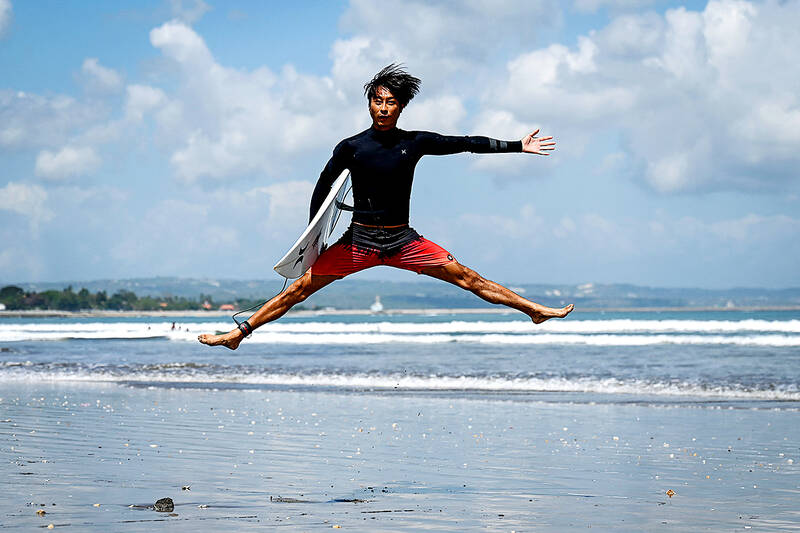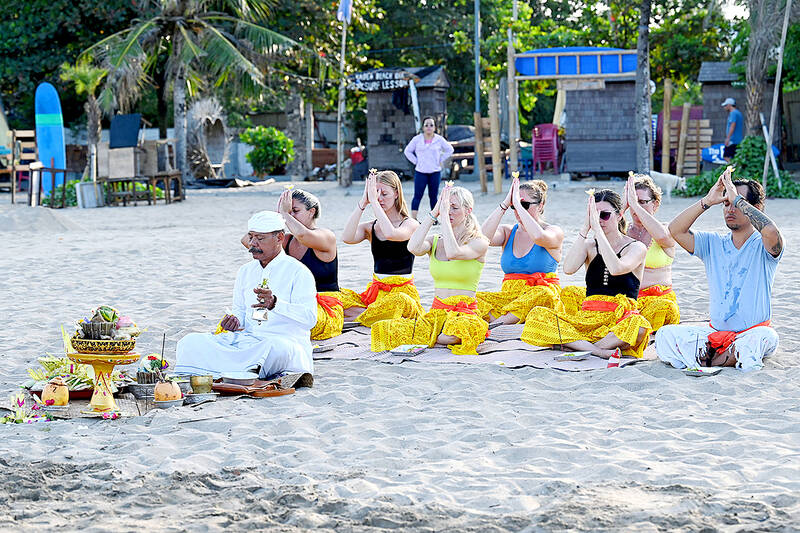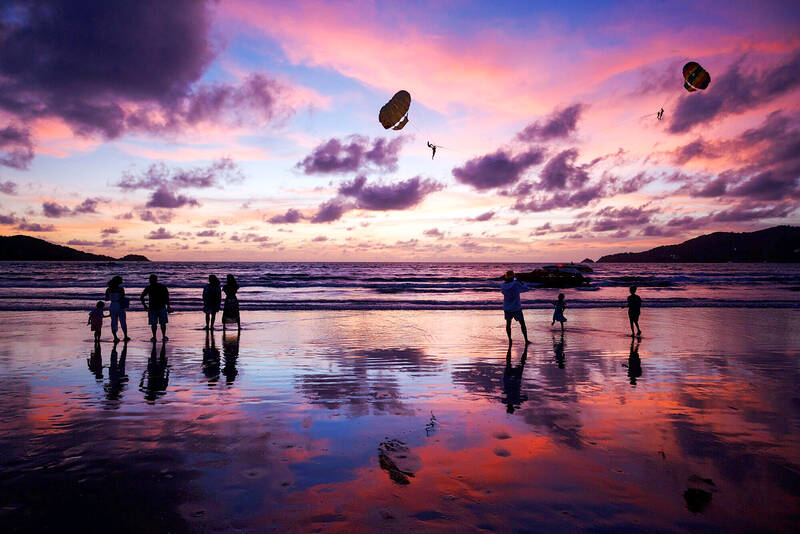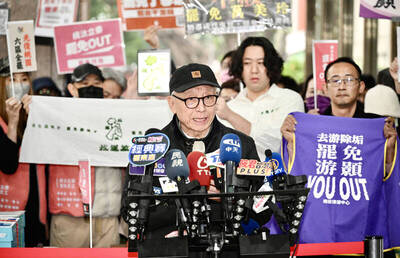Therese-Heather Belen is living the dream, working remotely full-time while traveling across Vietnam, Thailand, Japan and India.
But the dream comes with a catch: Her workday starts in the evening and lasts through the night. To stay in the same timezone as coworkers at her New York-based marketing tech firm, about a 12-hour difference, she works and takes meetings into the wee hours of the morning.
For some, ambitious “workcation” trips like these are seen as a way to make up for lost time during pandemic lockdowns. For others who choose to wander far from their home timezone, such adventures can veer off course, becoming hellish journeys to the land of sleep deprivation.

Photo: AFP
Belen, who is traveling with Remote Year, a program that functions like a kind of study abroad trip for working adults, said this lifestyle allows her to experience more of the world than would ever have been possible working a traditional 9-to-5. “You hear stories all the time like, ‘I went skydiving before I started my workday,’” she said.
Remote workers and so-called digital nomads have logged odd hours from hotspots like Bali and Goa long before COVID-19. But the abrupt shift to remote work during the pandemic pulled what was long an idle fantasy for many into the realm of the possible. Almost 17 million US employees describe themselves as digital nomads, more than double the pre-pandemic number, according to MBO Partners, a firm that connects companies with freelance talent.
The trend of longer work-leisure trips has accelerated as pent-up demand for international travel has boomed after years of restrictions. That’s giving some digital nomads a bad reputation for driving up prices and trampling local culture in popular vacation destinations, but it hasn’t slowed them down. Dozens of countries are marketing a new class of visas to these professionals to compete for tourism dollars. And despite many highly publicized return-to-office announcements in recent months, some degree of remote work remains a fixture at most companies.

Photo: AFP
Many remote workers who have decamped to far-flung locales will, like Belen, work a split shift, logging on for a few hours in the evening through midnight, before taking a few hours to sleep and then waking up to log back on for another round.
And it works, to a certain extent. Her mom was a labor and delivery night shift nurse, so the idea of sleeping during daylight hours didn’t strike her as outlandish. She’s usually online with coworkers until 1am or 2am and then sleeps in until 10am or so before waking and catching up on e-mails. But because her job revolves around meetings, she’s sometimes on call at all hours. “Tonight I do have a 3:30 to 4 am meeting that I have to be on,” she said. “So I have many, many alarms that are set for the most random hours for me to jump on that meeting and then just fall back to sleep after.”
Some, like Belen’s partner, a software engineer, have an easier time with timezone differences. That’s because their jobs are less meeting-heavy and more open to asynchronous work, so they have more flexibility to get things done on their own schedule.

Photo: Bloomberg
Tue Le, chief executive officer of Remote Year, estimates that somewhere around 15 percent of program participants traveling in Asia keep strict US hours by staying up overnight. Roughly another third work flexible hours with a mix of evenings or early mornings to collaborate with coworkers back home.
The graveyard shift can work for those wired to stay alert deep into the night, said Ilene Rosen, a sleep medicine professor at the Hospital of the University of Pennsylvania. But for many others such schedules go against ingrained circadian rhythms, making it challenging or impossible to get enough sleep. As anyone who has had to get up early and go to work after a terrible night’s sleep can attest, it can drain energy, zap concentration and undermine emotional regulation. The bottom line: Consistently pulling all-nighters is generally not a good idea for optimal health, let alone top work performance.
“The science as we have come to understand it over the last 20 years indicates that while it may be exciting, and that it may be even doable for some short period of time, it isn’t great for our bodies,” Rosen said. Studies have found longer stretches of night-shift work have been associated with more serious health consequences, like heart disease and cancer.
Still, some travelers are determined. Jessica Hilbrich, who works remotely for a data and IT consulting firm based in Indianapolis, committed to working a full eight hours through the night, without naps, when she went to Southeast Asia this past spring. That meant logging on at 8pm and signing off around 4am. There were often a few other people in the co-working space when Hilbrich began her workday in the evening, but the place was usually empty by midnight. It’s important to her that her performance doesn’t waver — whether she’s working fully remotely from her home outside of Chicago or from a co-working space halfway across the world.
One strategy Hilbrich developed is front-loading the tasks she finds the most cognitively demanding, like deep thinking and writing, earlier in the night when she’s sharpest. Once her workday is over, she winds down to get some sleep and then takes lots of naps as needed.
“Don’t let people nap-shame you,” she said.
For Hilbrich, this kind of travel comes with a different mindset. It’s not a “vacation,” which to her is about relaxation above all. It’s more about forming a genuine connection with a place and the people who live there. “I can’t afford to quit working, and this way I can experience more places while I’m younger, before I retire.”
Even with such best practices, the night shift can be punishing — and isn’t for everyone. After two months, Belen’s sleep schedule has been completely thrown off.
“I would say I’m struggling — everyone I know is struggling to some extent.”
Some people she’s met while traveling have had to quit their jobs. Others have had to cut back their hours. One person she knows was fired. Often, she said, the inescapable truth is that some people simply are less available — whether they want to be or not.
While some digital nomads make it work, others who can’t hack it end up throwing in the towel and going home.
“I’ve met a lot of people who say I would never do that, and won’t even try,” said Carolina Zuniga, who works remotely in marketing and is heading back to Bali for the third time from her home in Costa Rica. She’s met others that start out very enthusiastic, but swiftly run into problems. Their trip turns into a bust, too exhausted to go out and do or see anything.
Jordan Carroll, a career coach, calls it the “hell shift.” Years ago he gave it a go while traveling through Thailand and Indonesia, heading out at midnight to catch a ride on a motorcycle o a 24-hour co-working space. Some nights he tried splitting the shift into two. Other nights he tried powering straight through. Neither worked. “For me, it was so jarring,” he said. “Your internal clock would be so messed up. I couldn’t really function. Even if I went to socialize with friends I was always tired. I wasn’t able to really be myself.”
All of these concerns are top of mind for Zuniga. She’s just turned 30 and said sleep deprivation takes more of a toll now than it did when she was traveling in her early 20s. “I’m more concerned this time, but I’m curious to see how it goes,” she said.
For those still determined to give it a shot, University of Pennsylvania’s Rosen advises keeping as much consistency as possible, even on weekends. Compensate with naps as needed and keep your room as dark as you can when you sleep during daylight hours. She gives the same advice to incoming medical residents as they prepare for their first overnight shifts. That includes avoiding light at dawn at all costs — wear dark sunglasses, even if it’s overcast. Melatonin can be useful to regulate sleep, but timing doses can be tricky if daily sleep schedules vary.
Belen can relate. She knows all the tips and tricks. Even so, she ended up coming down with a nasty cold before a long-planned motorbike trip. After a week of worrying whether it would prevent her from making the trip, her home remedies kicked in and she was able to recover enough to go. It was hard, but worth it, she said.
“I’d do it again in a heartbeat.”

The Democratic Progressive Party (DPP), Chinese Nationalist Party (KMT), and the country’s other political groups dare not offend religious groups, says Chen Lih-ming (陳立民), founder of the Taiwan Anti-Religion Alliance (台灣反宗教者聯盟). “It’s the same in other democracies, of course, but because political struggles in Taiwan are extraordinarily fierce, you’ll see candidates visiting several temples each day ahead of elections. That adds impetus to religion here,” says the retired college lecturer. In Japan’s most recent election, the Liberal Democratic Party lost many votes because of its ties to the Unification Church (“the Moonies”). Chen contrasts the progress made by anti-religion movements in

Taiwan doesn’t have a lot of railways, but its network has plenty of history. The government-owned entity that last year became the Taiwan Railway Corp (TRC) has been operating trains since 1891. During the 1895-1945 period of Japanese rule, the colonial government made huge investments in rail infrastructure. The northern port city of Keelung was connected to Kaohsiung in the south. New lines appeared in Pingtung, Yilan and the Hualien-Taitung region. Railway enthusiasts exploring Taiwan will find plenty to amuse themselves. Taipei will soon gain its second rail-themed museum. Elsewhere there’s a number of endearing branch lines and rolling-stock collections, some

This was not supposed to be an election year. The local media is billing it as the “2025 great recall era” (2025大罷免時代) or the “2025 great recall wave” (2025大罷免潮), with many now just shortening it to “great recall.” As of this writing the number of campaigns that have submitted the requisite one percent of eligible voters signatures in legislative districts is 51 — 35 targeting Chinese Nationalist Party (KMT) caucus lawmakers and 16 targeting Democratic Progressive Party (DPP) lawmakers. The pan-green side has more as they started earlier. Many recall campaigns are billing themselves as “Winter Bluebirds” after the “Bluebird Action”

Feb 24 to March 2 It’s said that the entire nation came to a standstill every time The Scholar Swordsman (雲州大儒俠) appeared on television. Children skipped school, farmers left the fields and workers went home to watch their hero Shih Yen-wen (史艷文) rid the world of evil in the 30-minute daily glove puppetry show. Even those who didn’t speak Hoklo (commonly known as Taiwanese) were hooked. Running from March 2, 1970 until the government banned it in 1974, the show made Shih a household name and breathed new life into the faltering traditional puppetry industry. It wasn’t the first